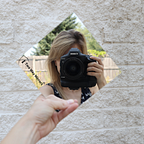True Mirror — What Do You Actually Look Like?
Also known as a non-reversing mirror or a flip mirror, the reflection in a True Mirror shows you exactly what you look like from someone else’s point of view.
When you look into a mirror, what do you see? — “Well, I see my reflection obviously”
You’re not entirely wrong, but you’re not entirely correct either. The reflection that is seen in a mirror, is a reversed reflection. If you’re wearing a shirt with lettering on it, the letters will show up backward in a standard mirror, so technically, your face is backward too.
From the way we style our hair, to the way we smile, our faces are surprisingly not perfectly symmetrical. The face that you’re so used to seeing is in fact not the face the rest of the world sees.
With being huge glass/mirror aficionados, this immediately sparked our interest. After doing a little research, we were lucky enough to get the chance to test out a True Mirror, and the results were astounding.
When I first looked into the mirror, I was a little taken aback. My face looked…uneven, crooked almost. The confusion was shortly followed by a strange sense of admiration. This was, however, my face. This is what my friends and family have seen my whole life, which was comforting.
Everyone’s relationship to the mirror is different because it’s a feedback loop with distortion — you just don’t know where each individual’s thought process will go with this altered communication that comes from the mirrored image.
— John Walter, Founder of True Mirror
A non-reversing mirror is made using first surface mirrors. A first surface mirror is simply a mirror that has a reflective coating on the face of the glass rather than the backside, as a standard mirror. You can see the difference when you touch a finger to the glass. Rather than there being a gap between your finger and the reflection, they will be touching.
Two first surface mirrors are joined together at a perfect and seamless 90 degree right angle. This sounds simple, but the glass needs to be cut by a skilled glass cutter and assembled with careful engineering. It needs to be at a perfect angle, with a perfectly sharp, flat edge, otherwise, you’d see a seam within the mirror.
There is a small adjustment knob on the side, which you can turn yourself to calibrate the angle to a perfect 90 degrees. You might have to mess with it for a second, but you’ll know it’s ready when the seam disappears and your face has a continuous reflection.
True Mirrors are sometimes found in museums, and many people are less than thrilled with what they see. People often find it a bit disconcerting because the eye contact is completely different from what you’d expect. Some even go as far as to describe it as hypnotic, spiritual, or mystical. The part that’s the most uncomfortable in my opinion, is that you’re really making direct eye contact with yourself!
If you stare at yourself in a True Mirror, it won’t have the same impact as if, for instance, you actually try to smile at yourself. It’s literally impossible to keep a smile going in mirrors for more than a second or two, whereas your smile, your genuine smile, actually looks genuine and can grow in the True Mirror.
— John Walter, Founder of True Mirror
Non-reversing mirrors can be found on Amazon or the True Mirror website. If you aren’t interested in buying one, but simply want the experience, check museums! There are currently 18 museums around the world that have a True Mirror for you to try out yourself.
**This is not a paid promotion — we were just really stoked about the product.
